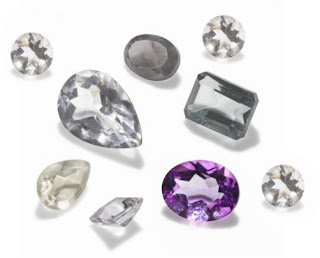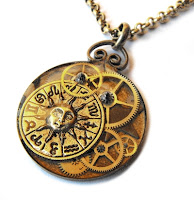Aren't custom orders the same thing as commissions?
In both cases, someone is paying me to make something I wouldn't otherwise make. The terms seem interchangeable, but I think of custom orders as something where I've
offered a customizable design -- maybe birthstone
bracelets with a choice of colors or stones, or a particular style of
wire ring in different sizes. Or a custom order might happen when I've designed a piece of jewelry and listed it for sale, but someone asks me to make another for them, in pink instead of red.
 |
| True story. |
On the other hand, commissions are when I'm contacted out of the blue by someone asking me to create something to their specifications. It might be a request for a hundred pins that a retailer wants to purchase at wholesale, a batch of acid-etched logo pendants for a fundraiser, or a "Victorian fairy jewelry set with matching necklace, bracelet and earrings, to go with my costume..."
In the early years of my online jewelry selling, I offered several customizable items and I accepted many commissions. I was eager for business and happy to help others. My primary motivations were:
- A love of creating jewelry
- The desire to make others happy
- To build my reputation, customer base and skills
- Money -- any little bit I could get
Now, I rarely accept commissions nor will I fill custom orders. Part of the reason for this is that I have so little time. Jewelry is not my full-time business any longer.
But even when I still created jewelry on a daily basis, after awhile I'd ceased accepting queries for custom pieces because 95% of the inquiries were mucked up in some way. (Feel free to substitute an "F" for the "M" if you so desire.) Either the request itself was unreasonable or the process of filling it was a major headache.
I tried implementing a few guidelines and requirements, such as a 50% non-refundable deposit before I would begin work. I had a design fee of "$20 that would be added to all custom orders" which weeded out that folks who, bless them, could only afford to spend $20 for my materials, time and expertise.
But I still encountered a lot of misconceptions, assumptions, and downright rudeness. Things like:
- "You should be happy for any money you can get." Well, no. I don't want to spend twelve hours -- between emailing back and forth with the customer, creating initial design sketches, searching for and purchasing the right parts, actually making then photographing the piece (and/or each stage of the piece) for their approval -- just to make a $30 item. Minus the cost of materials, social security and income taxes, I'm making less than $1 an hour. That's an insult.
- "You should be happy to have my business." Not necessarily. Some customers are rude, unreasonable, crazy, forgetful, cheap, ignorant, slanderous and impossible to please. People who sell their art or craft are not the same as a business such as Wal-Mart or Sears. They are just one individual who is giving a little piece of their heart and soul when they make something. They should not be treated poorly, and they do not have an obligation to try and please everyone who walks up to their booth or visits their website. And artists who are in demand have the luxury of picking and choosing their projects.
- "It should be easy for you to make another one of these for me. After all, it is just like the one you made before." Again, no. I'm one person working from home, not a jewelry supply warehouse. If the piece is unusual (and it probably is, that's why they want it, right?) then it either involves unique parts and/or a difficult technique. Just because I was able to find a particular bead, charm or watch part on Etsy or eBay or some other supplier last year, doesn't guarantee I'll be able to find that part any longer. And just as clothing styles and trends change, just as car parts differ from model to model and year to year, jewelry materials constantly change. There are some basics -- jump rings, Czech glass, etc -- but colors and styles do come and go.
- "But I want it. Really bad." I quote the Dread Pirate Roberts: Get used to disappointment. Your desire, while flattering, does not affect the price of sterling silver or the value of my time.
 | |
| An example of something I can only make once. It features a real watch face and parts from some old, broken antique jewelry I found at a flea market. |
Suggestions for people seeking a custom order
- Expect to pay at least $50, maybe even $100 or more. Artists who are in demand can demand higher prices. This is not because they are asshats, but because their time is limited and they have to make the best of it. It's basic supply and demand stuff. Plus, if they're popular, people are already paying them tons to do the epic things, so why would they stop all that to make your $30 pendant? Even if they're not in high demand (however you define that), artists and crafters are people who are giving you their time and effort. Minimum wage is at least $7 and that's unskilled labor. This is skilled labor. A labor of love, yes, but still labor. They should be able to reasonably expect at least $10-$12 an hour, above and beyond the cost of materials, PayPal fees, taxes and shipping.
- Check Etsy before you ask for a custom item. Seriously. There's like a bazillion crazy things on there. Someone emailed me the other day asking if I'd make him a steampunk ring. Searching for the words "steampunk ring" on Etsy comes back with more than TEN THOUSAND results. Pick any random thing. "Green pickle." More than 400 results. "Mustache baby shower." Over 1,400 results. "Clockwork angel." Almost a hundred items. If nothing else, you'll be armed with a reasonable expectation of cost and a pile of pictures so you can show the artist, "I want something like this item, but with this thing from this other item, and with this other thing, but in brass..."
- Don't ask for the moon unless you're willing to pay them to build a rocketship. In other words, no, I will not make you an exact replica of each panel of the Gundestrup Cauldron, acid-etched on hammered and riveted copper and brass, but make each face look like one of your children, with matching earrings and bracelet, for only $60. That may seem like a lot of money to you, but twenty hours of my time is a lot to me.
- Do not request an item unless you are willing to follow through, return email in a timely manner, and pay the artist. This should be a no-brainer, but you'd be surprised.
- Don't be a dick during the process. Be patient, be kind, be helpful, be gracious. That doesn't mean you should accept something you don't want or that you shouldn't ask questions, but at least be willing to compensate the artist for the time they spend trying to meet your demands and any materials they purchase on your behalf, even if you realize that they are not going to be able to fill your request to your satisfaction.
- Don't expect a rush job. This is handmade stuff, it takes time. Many artists and crafters have other jobs and obligations -- and probably several pieces to make ahead of yours. It's not our fault you waited until the week of your girlfriend's birthday.
- Don't bargain or barter. I don't mind bartering -- once in awhile -- and I've met many fellow artists who enjoy it as well. If you have something of worth to offer, go ahead and offer it. But be realistic -- is a bar or two of your sandalwood soap equal to a sterling silver pendant with real garnets? Don't be offended if refused and don't take up more of the artist's time trying to talk them into a trade. As for bargaining, if the artist says it will cost $100, don't ask "Would you do it for $50?" If they could and would, they'd have already said so. Instead, say, "Unfortunately, I only have $50 to spend. Is there some way to do a smaller version or use different materials to meet my budget?" Which ties into...
- Give as much information as you can in your inquiry. I don't mean ten pages of design specs, but something more than "Hey, I saw this thing and I wondered if you could make one for me." Please. Don't make me have to ask: What thing? Where did you see it? When do you need it? How much are you willing to pay? Who are you? Is your email and contact info correct? Are you inside or outside the US? Are you an individual or a company? Do you want one or one hundred?
- Familiarize yourself with the artist's accepted method(s) of payment. If they have a big PayPal logo on their site and you foster a rabid hatred for PayPal, don't expect the artist to open an Amazon account just for YOU. Do not expect the artist to accept a credit card number in email (ye gods and little fishies, I can't tell you how many people wanted me to do this, though it's insanely insecure and no matter how much I kept explaining that I couldn't just "put their number into PayPal for them" or run it through the credit card machine that I did not possess). Don't expect them to take an out of state personal check #103 from a stranger. Many online sellers won't even accept money orders any longer, because there are so many fakes.
Jen Hilton makes one-of-a-kind jewelry sold through her website JLHJewelry.com. She is the founder of the Triangle Jewelry Makers and is featured in the books "Steampunk Style Jewelry: Victorian, Fantasy, and Mechanical Necklaces, Bracelets, and Earrings" and "1000 Steampunk Creations: Neo-Victorian Fashion, Gear, and Art" available at Amazon and other booksellers.
















